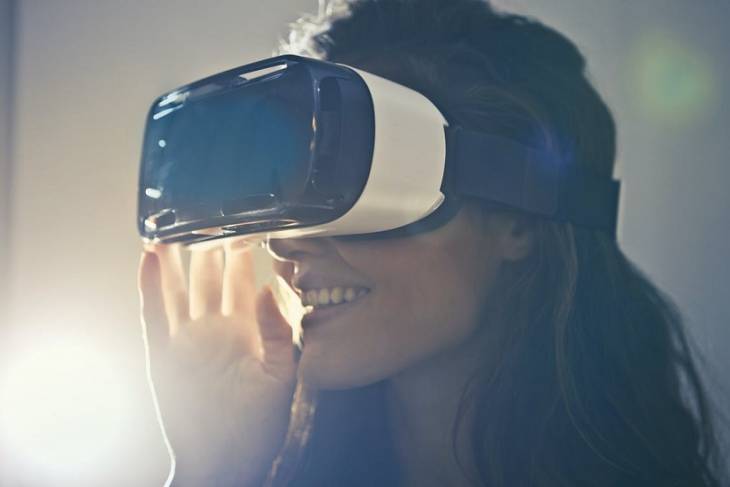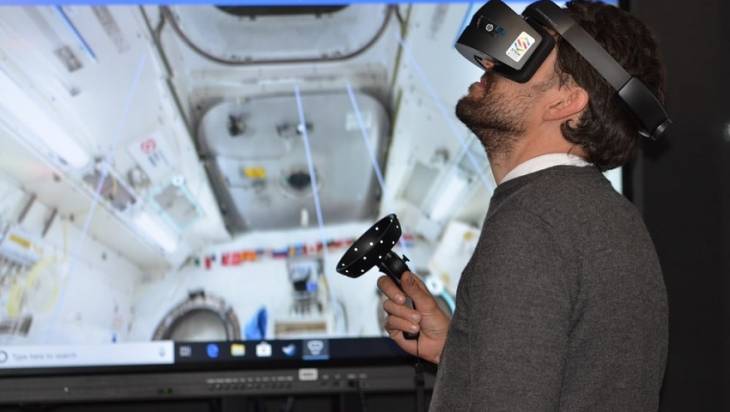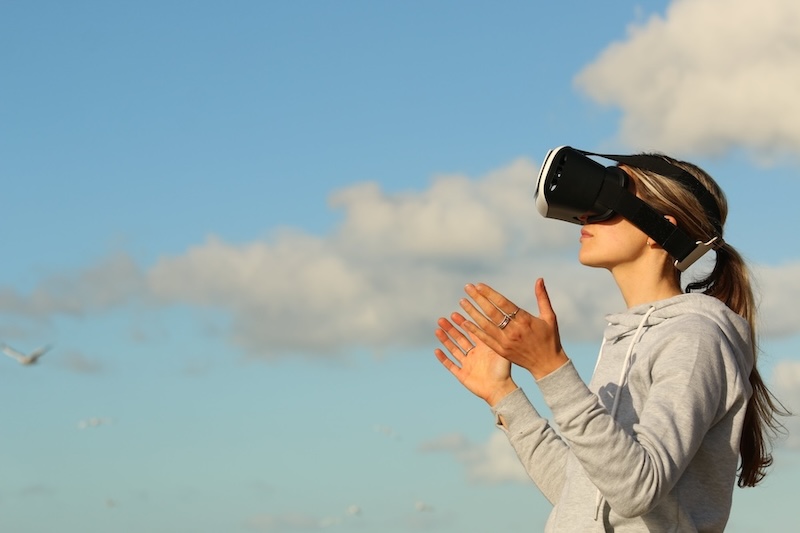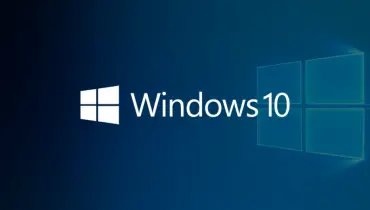Innovation Boom: Virtual Reality Trends Shaping the Future

Many people often think of science fiction films like 'Minority Report' when Virtual Reality (VR) is mentioned. The truth, however, is that this technology is no longer the stuff of science fiction.
Nowadays, VR blends seamlessly into our daily lives. From healthcare to education, travel, and video games, virtual reality is everywhere. And VR is here to stay.
Understanding Virtual Reality in a Modern World
Virtual Reality technology is a computer-generated environment with real-life scenes and objects that make the user feel fully immersed in their virtual surroundings. This virtual world or environment is viewed using a device known as a headset or helmet for Virtual Reality.
VR allows us to immerse ourselves in digital simulations as if we were one of the characters in video games. This ability to immerse ourselves in visual simulations has a wide (and growing) range of applications, such as allowing doctors to learn how to perform heart surgery and athletes to improve the quality of sports training for maximum performance.
Although VR might seem like a new thing, the roots are not as new as you might think. Experts contend that one of the first Virtual Reality devices was called Sensorama, a machine with an integrated seat that played 3D movies, gave off-odors, and generated vibrations to make the experience as vivid as possible. This rudimentary VR design dates back to the mid-1950s.
Subsequent advances in hardware and applications over the years has carried with it a radical change in both electronics and VR system architecture. Today, Virtual Reality boasts one of the highest growth potential.
According to 2024 projections by the International Data Corporation (IDC), the augmented reality and virtual reality (AR/VR) market will grow 46.8% year over, with investment in VR and AR headsets expected to rise in the coming years.
AR/VR Growth Rates and Projections

Both augmented reality and virtual reality technologies continue to be essential to the digital transformation strategies of businesses and organizations, with investment in AR/VR surpassing that of the consumer sector.
In Europe, it was estimated that more than half of the larger European companies would have a VR and RA plan by 2020. Although the COVID-19 pandemic tempered market growth in 2020, expectations for the long term continue to be very good, with the global market for VR and AR projected will surpass $250 billion U.S. dollars by 2026.
Amid the projected growth rates, the VR/AR sector needs solutions that go beyond recreation, travel, or advertisement, and solutions that are accessible to more consumers. There is also a need to develop computer interfaces to prevent flaws such as slicing, which lets some rigid objects look as though they can be pushed through.
Moreover, to reduce undesired effecs that VR causes in some people, like motion sickness, which consists of dizziness caused by the difference between our body's orientation and what is seen in the virtual world, big technology firms are now focusing on designing headsets that do not require cables and for displaying images in HD.
Tech firms are also developing 8 K headsets for Virtual Reality, with even more powerful processors. There's also work going into incorporating Artificial Intelligence more widely in VR in the coming years. Even the new 5G standard has fascinating scenarios for VR evolution.
5G technology will allow connectivity between more VR devices and large user communities. Furthermore, 5G's nearly invisible latency is expected will enable consumers to receive images in real-time, almost as if they were seeing them with their own eyes.
Exciting Virtual Reality Trends Shaping Our World Today

Here are some of the most exciting virtual reality technology trends about what's changed and what's coming over the horizon:
1. Improved Visuals
Early headsets used mobile phone screens that had never been designed to be viewed so close up – this caused pixelated images and the 'screen-door' effect that reduced immersion.
Since then, we've seen steady improvements in the quality and fidelity of the VR screens, and professional headsets such as Varjo and Pimax have twice or even four times the first-generation resolution offering '20:20' vision – for a price!
More pixels need more processing power to render, especially when we want photorealistic graphics. Fortunately, GPU capacity is increasingly improving and foveated rendering techniques – a device-performance optimization technique that allows the GPU to concentrate on only the part of the picture where the eye is centered – helps a great deal today.
2. Increased Comfort
It's increasingly becoming easier and more comfortable to wear VR headsets in a single session for 30 minutes to an hour or more before our eyes start to get sore. This is partly due to more advanced headsets and optimized headset weights and VR software.
When people focus on an object close up, our pupils align slightly as compared to far apart. The lens on some older VR headsets had a single focal length, meaning we needed to go 'cross-eyed' to focus outside of that length on objects.
Luckily, newer VR headsets like Oculus have innovated new concept lenses that can change the focal point to where your eyes are looking dynamically. A welcome result of dynamic focal points is that this also reduces the headset's scale and weight.
3. Integration of 5G and the cloud
VR content is split down into a few versions: 'desktop' and 'tethered' (the latter involving a PC). This offers users a very different degree of VR experience, owing to the disparity in computing capacity between mobiles and PCs.
Oculus has also introduced a connect for their handheld Quest headset so that it can be used optimally in both desktop and tethered mode. But that is just a part of the solution. The rollout of superfast low latency 5G infrastructures ensures that we can overcome this issue by delivering content wirelessly to the headset in the cloud and downloading it.
Google's Stadia also does this for mainstream games, and adding that to VR would be the next logical addition, while more changes to the methodology would be needed.
The broadcasting of headphone apps would reduce weight, expense, and power usage. While making it easier and cheaper to access content since it won't require downloading and installing individual applications. Instead, it would allow linked VR interactions with 'meta-verses' that we can switch seamlessly between while we currently browse internet services.
Many believe this is potentially only a few years away from widespread commercial release. Still, it will pose several intriguing possibilities as well as concerns about who controls the channels on which we all view our modern environment.
4. More Intuitive User Interfaces
Another common complaint on the VR experience was ease-of-use. Users had to learn how to use new handheld controllers while effectively being blindfolded . And with no VR programming language approved internationally, even each program behaved a little differently.
Luckily, strong programming practices for VR have been converging, making them more intuitive. New controls such as the 'Knuckles' controller from Valve cleverly merge finger recognition with a creative interface that hangs from the hand, so it doesn't look like you are carrying it.
Hand monitoring using cameras on the headset is more possible on commercial headsets. For specific applications like the one we designed for ANA, controllers are not needed at all.
Developments in speech recognition mean we say commands to AI characters or speak more naturally to them. If you want to look ahead, mind regulation is still arriving – apps that can be programmed to follow commands already on the market.
All of this means more natural interactions – this is what VR offers in the end.
5. Enhanced Social Interactions
Another complaint about VR is that it can feel isolated, cut off from the real-world. New headsets allow familiar integrations through innovative applications in the real-world and the virtual world, with the stated goal to provide human beings with a virtual environment where we can interact and socialize using a computer just as we do in the real world.
In other words, you don't have to be alone, single, or isolated anymore. A example here is Meta Horizon, a virtual world where you can find community, events, games, and everything in between for VR users. Users are not limited to interact as avatar versions of themselves and hold in-person remote meetings as animated characters; new VR systems feature photorealistic avatars representing nuanced facial gestures and signals that give the feel of being in the same room.
The rise in VR headsets also means more users can socialize and engage virtually. Some of the most immersive interactions to date include playing and working together in Virtual Reality.
Conclusion
In deed, there is more to Virtual Reality than a gimmick or just a fancy instrument. This technology is now built into our present reality, and it is poised to open up new opportunities and contribute to changes that will shape the future in the coming years.
Virtual Reality isn't science fiction any longer. It is an integral part of the modern world that you should not ignore to stay ahead of the curve both in your personal and professional life.




















